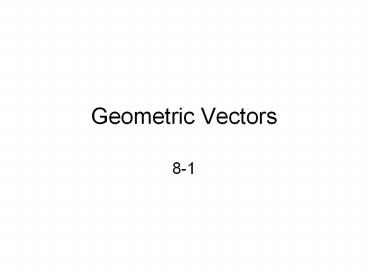Geometric Vectors - PowerPoint PPT Presentation
1 / 18
Title:
Geometric Vectors
Description:
Geometric Vectors 8-1 What is a vector? Suppose we are both traveling 65mph on Highway 169 and we pass each other going opposite directions. I m heading back from ... – PowerPoint PPT presentation
Number of Views:154
Avg rating:3.0/5.0
Title: Geometric Vectors
1
Geometric Vectors
- 8-1
2
What is a vector?
- Suppose we are both traveling 65mph on Highway
169 and we pass each other going opposite
directions. Im heading back from Tulsa and you
are heading to Tulsa. Describe our vectors.
3
Vector Definition
- A quantity that has both a magnitude and a
direction.
4
Definition
A vector is defined to be a directed line
segment. It has both direction and magnitude
(distance). It may be named by a bold-faced
lower-case letter or by the two points forming
it - the initial point and the terminal point.
Examples u or AB u would be considered the
magnitude here.
B
u
A
5
Look at the example on the board
- We have vector PQ, what is its magnitude?
- Absolute value bars are often used.
6
Standard Position
- If a vector has an initial point at the origin,
we consider it to be in standard position. - The direction of a vector in standard position is
given by the angle created between the positive
x-axis and the vector - Lets make a 115 degree vector r
7
Zero Vector
- Draw the zero vector in standard position.
8
Your turn
- Someone come up to the board and make a 4 inch 45
degree vector.
9
What would make two vectors equal?
10
Your turn
- Draw two vectors that have the same magnitude but
different directions. - Draw to vectors that are equal.
11
Can we sum vectors?
- What should we consider when summing a vector?
12
2 Methods for Summing Vectors
- 1. Parallelogram Method
- 2. Triangle (Tip to Tail) method.
- We refer to the sums as resultant vectors
13
Ok, lets add some vectors
- 1 student draw a vector
- 1 student draw another vector
- 1 student add the vectors
14
What is an opposite vector?
15
What are parallel vectors?
16
Definition
- We often refer to the two vectors used for a sum
of vectors as the components of the resultant
vector For example
17
Definition
- Scalar Quantity A quantity with only a
magnitude. - Give me some examples of scalar quantities.
18
Lets practice some
- 14, 15, 16, 17, 21, 25, 31































